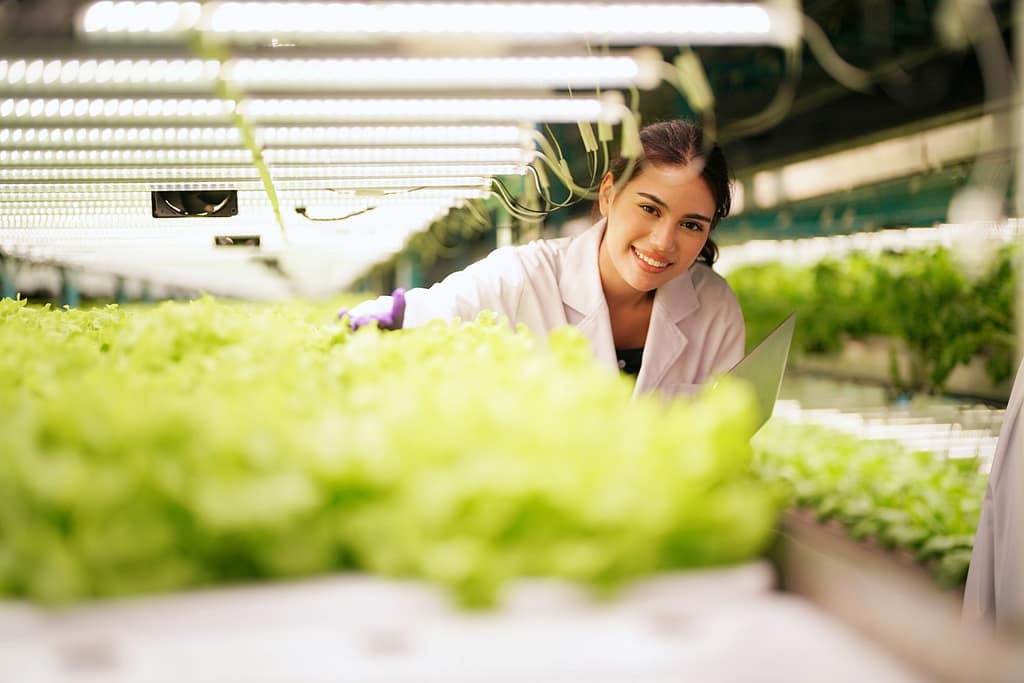
Aeroponic farming is an innovative method of growing plants without soil or traditional growing mediums, where roots are suspended in the air and misted with nutrient-rich water. This farming technique offers several advantages, including faster growth rates, reduced water usage, and the ability to grow crops in confined spaces, making it an ideal solution for urban and vertical farming.
Understanding Aeroponics: The Basics
Aeroponics is a type of hydroponic system, but instead of submerging the plant roots in water, they are exposed to air and periodically misted with a nutrient solution. This method allows the roots to absorb more oxygen, leading to healthier and faster-growing plants. It’s a highly efficient and sustainable way to grow food, particularly in environments where soil is scarce or unsuitable for traditional farming.
Key Components of an Aeroponic System:
- Growth Chamber: The enclosure where the plants’ roots are suspended. It’s designed to maintain a controlled environment for the roots.
- Misting System: Delivers nutrient-rich water to the roots in the form of a fine mist.
- Reservoir: Holds the nutrient solution that will be sprayed onto the roots.
- Pump: Circulates the nutrient solution from the reservoir to the misting system.
- Lighting: Typically LED grow lights are used to provide the necessary light for photosynthesis.
- Timer: Controls the intervals at which the misting system operates, ensuring that the roots receive a consistent supply of nutrients and oxygen.
Benefits of Aeroponic Farming
Aeroponic farming offers numerous benefits, making it a popular choice for both small-scale hobbyists and commercial growers.
Faster Growth Rates
Plants grown using aeroponics tend to grow faster than those grown in soil or other hydroponic systems. The direct exposure of roots to oxygen and nutrients results in rapid nutrient absorption, which accelerates plant growth.
Efficient Use of Water and Nutrients
Aeroponics uses significantly less water than traditional farming methods. The misting system ensures that plants receive just the right amount of water and nutrients, reducing waste and making this method more sustainable.
Space-Saving and Scalable
Aeroponic systems can be stacked vertically, making them ideal for urban farming or areas with limited space. This scalability makes it possible to grow large quantities of food in small spaces, which is crucial for addressing food security in densely populated areas.
Disease Prevention
Since the roots are not submerged in water, the risk of waterborne diseases is greatly reduced. The sterile environment of the growth chamber also minimizes the chances of soil-borne diseases affecting the plants.
Setting Up Your Aeroponic Farm
Starting an aeroponic farm requires careful planning and investment in the right equipment. Here’s a step-by-step guide to help you get started.
Choose the Right Location
The first step in setting up an aeroponic farm is selecting a suitable location. Aeroponic systems can be set up indoors, in greenhouses, or outdoors under certain conditions. When choosing a location, consider the following factors:
- Temperature Control: Aeroponic systems require a stable temperature for optimal plant growth. Indoor setups offer better control over temperature and humidity.
- Lighting: Adequate lighting is crucial for plant growth. If setting up indoors, ensure you have access to sufficient natural light or invest in high-quality LED grow lights.
- Space Availability: Consider the space you have available and whether it can accommodate a vertical setup if you plan to maximize your growing area.
Gather the Necessary Equipment
To set up your aeroponic farm, you’ll need the following equipment:
- Aeroponic Growth Chamber: Choose a chamber that suits the size of your operation. For larger setups, consider modular chambers that can be expanded as needed.
- Misting System: Invest in a reliable misting system that can deliver a fine, consistent mist to the roots.
- Nutrient Reservoir and Pump: Ensure that the reservoir is large enough to hold sufficient nutrient solution, and the pump is powerful enough to circulate it effectively.
- LED Grow Lights: These are essential if you’re growing plants indoors or in areas with limited natural light.
- Timers and Controllers: These will automate the misting intervals, ensuring your plants receive the necessary nutrients at the right times.
Prepare the Nutrient Solution
The nutrient solution is a vital component of aeroponic farming. It should be a well-balanced mix of water and essential nutrients that meet the specific needs of the plants you are growing. You can purchase pre-mixed nutrient solutions or create your own, but it’s crucial to monitor and adjust the nutrient levels regularly to ensure optimal plant health.
Selecting Crops for Aeroponic Farming
Not all plants are equally suited for aeroponic farming. Some crops thrive in an aeroponic system, while others may require more traditional growing methods. Here are some of the best crops to grow in an aeroponic system:
Leafy Greens
Leafy greens like lettuce, spinach, and kale are ideal for aeroponic systems. They have relatively short growing cycles and thrive in the oxygen-rich environment provided by aeroponics.
Herbs
Herbs such as basil, mint, and cilantro are also well-suited for aeroponic farming. They grow quickly and can be harvested multiple times, making them a profitable choice for both home and commercial growers.
Strawberries
Strawberries are a popular choice for aeroponic farming, especially in vertical setups. They require specific nutrient levels and careful attention to light and temperature, but the results can be highly rewarding.
Tomatoes and Peppers
These fruiting plants can be grown in aeroponic systems, although they require more space and support structures. They also need precise control over nutrients and environmental conditions, making them better suited for experienced growers.
Operating and Maintaining Your Aeroponic Farm
Once your aeroponic system is set up and your crops are planted, ongoing maintenance is crucial to ensure a successful harvest.
Monitoring and Adjusting Nutrient Levels
Regularly check the nutrient solution to ensure it remains balanced and meets the needs of your plants. Use a pH meter and an electrical conductivity (EC) meter to monitor the pH and nutrient concentration of the solution. Adjustments may be necessary as your plants grow and their nutrient requirements change.
Managing Light and Temperature
Proper lighting and temperature control are essential for healthy plant growth. Ensure your grow lights are positioned correctly and provide the right spectrum and intensity for your plants. Monitor the temperature in the growth chamber to keep it within the optimal range for your crops.
Preventing and Managing Pests
Although aeroponic systems reduce the risk of soil-borne diseases, they are not entirely immune to pests. Regularly inspect your plants for signs of pests, such as aphids or spider mites, and take prompt action to manage any infestations. Using organic or biological pest control methods is preferable to maintain a healthy and sustainable growing environment.
Scaling Up: Commercial Aeroponic Farming
If you’re considering expanding your aeroponic farming operation to a commercial scale, there are several additional factors to consider.
Investment and Costs
Starting a commercial aeroponic farm requires a significant upfront investment in equipment, infrastructure, and energy costs. However, the potential for high yields, faster growth rates, and efficient resource use can lead to substantial returns on investment over time.
Market Research and Crop Selection
Before scaling up, conduct thorough market research to determine which crops are in demand in your area. Focus on high-value crops that can be sold at a premium, such as specialty herbs, microgreens, or organic produce.
Automation and Technology
Commercial aeroponic farms often incorporate advanced technology and automation to increase efficiency and reduce labor costs. Automated systems for nutrient delivery, climate control, and pest management can help you maintain consistent crop quality and maximize yields.
Sustainability and Environmental Impact
Commercial aeroponic farming offers significant environmental benefits, including reduced water usage and minimal chemical inputs. By adopting sustainable practices and promoting the environmental advantages of aeroponics, you can appeal to eco-conscious consumers and differentiate your products in the market.
Aeroponics vs. Hydroponics
Aeroponics and hydroponics are both soilless growing methods, but they have distinct differences. Understanding these differences can help you decide which method is best suited to your needs.
Water Usage
Aeroponics uses even less water than hydroponics, making it the more water-efficient option. However, hydroponic systems are generally easier to set up and maintain, making them a better choice for beginners.
Plant Growth and Yield
Both systems offer faster growth rates compared to traditional soil-based farming, but aeroponics typically results in healthier plants with higher yields due to better oxygenation of the roots.
Complexity and Cost
Aeroponic systems are more complex and require more precise control over environmental conditions, making them more challenging to manage. They also tend to be more expensive to set up initially, but the long-term benefits in terms of efficiency and yield can outweigh the costs
Is Aeroponic Farming Right for You?
Aeroponic farming represents a cutting-edge approach to agriculture, offering numerous benefits for both small-scale and commercial growers. By providing plants with the optimal environment for growth, aeroponics can lead to faster growth rates, higher yields, and more efficient use of resources. Whether you’re looking to start a small home garden or a large commercial operation, aeroponic farming offers a sustainable and profitable way to grow fresh, healthy produce.
Before you start, carefully consider your goals, budget, and level of expertise. With the right planning, equipment, and dedication, you can successfully launch an aeroponic farm that meets your needs and contributes to the future of sustainable agriculture.




